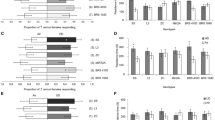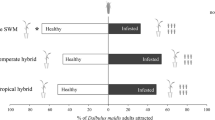Abstract
Fall armyworm (Spodoptera frugiperda) is a major global pest of many crops, including maize (Zea mays). This insect is known to use host plant-derived volatile organic compounds to locate suitable hosts during both its adult and larval stages, yet the function of individual compounds remains mostly enigmatic. In this study, we use a combination of volatile profiling, electrophysiological assays, pair-wise choice behavioral assays, and chemical supplementation treatments to identify and assess specific compounds from maize that influence S. frugiperda host location. Our findings reveal that methyl salicylate and (E)-alpha-bergamotene are oviposition attractants for adult moths but do not impact larval behavior. While geranyl acetate can act as an oviposition attractant or repellent depending on the host volatile context and (E)-4,8-dimethyl-1,3,7-nonatriene (DMNT) is an oviposition deterrent. These compounds can also be attractive to the larvae when applied to specific maize inbreds. These data show that S. frugiperda uses different plant volatile cues for host location in its adult and larval stage and that the background volatile context that specific volatiles are perceived in, alters their impact as behavioral cues.






Similar content being viewed by others
Data availability
All material is freely available upon request.
References
Babicki S, Arndt D, Marcu A, Liang Y, Grant JR, Maciejewski A, Wishart DS (2016) Heatmapper: web-enabled heat mapping for all. Nucleic Acids Res 44(W1):W147–W153. https://doi.org/10.1093/nar/gkw419
Beck JJ, Light DM, Gee WS (2014) Electrophysiological responses of male and female Amyelois transitella antennae to pistachio and almond host plant volatiles. Entomol Exp Appl 153:217–230. https://doi.org/10.1111/eea.12243
Beyaert I, Hilker M (2014) Plant odour plumes as mediators of plant-insect interactions. Biol Rev Camb Philos Soc 89(1):68–81. https://doi.org/10.1111/brv.12043
Block A, Vaughan MM, Christensen SA, Alborn HT, Tumlinson JH (2017) Elevated carbon dioxide reduces emission of herbivore-induced volatiles in Zea mays. Plant Cell Environ 40:1725–1734. https://doi.org/10.1111/pce.12976
Block AK, Hunter CT, Rering C, Christensen SA, Meagher RL (2018) Contrasting insect attraction and herbivore-induced plant volatile production in maize. Planta 248:105–116. https://doi.org/10.1007/s00425-018-2886-x
Block AK, Mendoza J, Rowley A, Stuhl C, Meagher RL (2020) Approaches for assessing the impact of Zea mays (Poaceae) on the behavior of Spodoptera frugiperda (Lepidoptera: Noctuidae) and its parasitoid Cotesia marginiventris (Hymenoptera: Braconidae). Fla Entomol 103:505–513
Bruce TJ, Wadhams LJ, Woodcock CM (2005) Insect host location: a volatile situation. Trends Plant Sci 10(6):269–274. https://doi.org/10.1016/j.tplants.2005.04.003
Cantelo WW, Jacobson M (1978) Corn silk volatiles attract many species of moths. J Environ Sci Health Part A Environ Sci Eng 14:695–707. https://doi.org/10.1080/10934527909374907
Carroll MJ, Schmelz EA, Meagher RL, Teal PEA (2006) Attraction of Spodoptera frugiperda larvae to volatiles from herbivore-damaged maize seedlings. J Chem Ecol 32:1911–1924. https://doi.org/10.1007/s10886-006-9117-9
Chung SH, Rosa C, Scully ED, Peiffer M, Tooker JF, Hoover K, Luthe DS, Felton GW (2013) Herbivore exploits orally secreted bacteria to suppress plant defenses. Proc Natl Acad Sci U S A 110(39):15728–15733. https://doi.org/10.1073/pnas.1308867110
De Boer JG, Dicke M (2004) The role of methyl salicylate in prey searching behavior of the predatory mite Phytoseiulus persimilis. J Chem Ecol 30:255–270. https://doi.org/10.1023/b:joec.0000017976.60630.8c
Degen T, Dillmann C, Marion-Poll F, Turlings TCJ (2004) High genetic variability of herbivore-induced volatile emission within a broad range of maize inbred lines. Plant Physiol 135:1928–1938. https://doi.org/10.1104/pp.104.039891
Dudareva N, Klempien A, Muhlemann JK, Kaplan I (2013) Biosynthesis, function and metabolic engineering of plant volatile organic compounds. New Phytol 198(1):16–32. https://doi.org/10.1111/nph.12145
Fritzsche Hoballah ME, Tamò C, Turlings TCJ (2002) Differential attractiveness of induced odors emitted by eight maize varieties for the parasitoid Cotesia marginiventris: is quality or quantity important? J Chem Ecol 28:951–968. https://doi.org/10.1023/a:1015253600083
Hu X, Su S, Liu Q, Jiao Y, Peng Y, Li Y, Turlings TCJ (2020) Caterpillar-induced rice volatiles provide enemy-free space for the offspring of the brown planthopper. Elife. https://doi.org/10.7554/eLife.55421
Love MI, Huber W, Anders S (2014) Moderated estimation of fold change and dispersion for RNA-seq data with DESeq2. Genome Biol 15:550. https://doi.org/10.1186/s13059-014-0550-8
Malo EA, Castrejon-Gomez VR, Cruz-Lopez L, Rojas JC (2004) Antennal sensilla and electrophysiological response of male and female Spodoptera frugiperda (Lepidoptera: Noctuidae) to conspecific sex pheromone and plant odors. Ann Entomol Soc Am 97:1273–1284. https://doi.org/10.1603/0013-8746(2004)097[1273:ASAERO]2.0.CO;2
Meagher RL (2001) Trapping fall armyworm (Lepidoptera: Noctuidae) adults in traps baited with pheromone and a synthetic floral volatile compound. Fla Entomol 84:288–292. https://doi.org/10.2307/3496181
Meagher RL, Landolt PJ (2008) Attractiveness of binary blends of floral odorant compounds to moths in Florida, USA. Entomol Exp Appl 128:323–329. https://doi.org/10.1111/j.1570-7458.2008.00711.x
Meagher RL Jr, Mitchell ER (1998) Phenylacetaldehyde enhances upwind flight of male fall armyworm (Lepidoptera: Noctuidae) to its sex pheromone. Fla Entomol 81:556–559. https://doi.org/10.2307/3495958
Nagoshi RN, Goergen G, Tounou KA, Agboka K, Koffi D, Meagher RL (2018) Analysis of strain distribution, migratory potential, and invasion history of fall armyworm populations in northern Sub-Saharan Africa. Sci Rep 8:3710. https://doi.org/10.1038/s41598-018-21954-1
Oksanen J, Blanchet FG, Friendly M, Kindt R, Legendre P, McGlinn D, Minchin PR, O'Hara RB, Simpson GL, Solymos P, Stevens MHH, Szoecs E, Wagner H. (2019) Vegan: community ecology package. R package version 2.5-2. host site: https://CRAN.R-project.org/package=vegan
Oluwafemi S, Bruce TJ, Pickett JA, Ton J, Birkett MA (2011) Behavioral responses of the leafhopper, Cicadulina storeyi China, a major vector of maize streak virus, to volatile cues from intact and leafhopper-damaged maize. J Chem Ecol 37:40–48. https://doi.org/10.1007/s10886-010-9891-2
Pinto-Zevallos DM, Strapasson P, Zarbin PHG (2016) Herbivore-induced volatile organic compounds emitted by maize: electrophysiological responses in Spodoptera Frugiperda females. Phytochem Let 16:70–74. https://doi.org/10.1016/j.phytol.2016.03.005
Rering CC, Beck JJ, Hall GW, McCartney MM, Vannette RL (2018) Nectar inhabiting microorganisms influence nectar volatile composition and attractiveness to a generalist pollinator. New Phytol 220:750–759. https://doi.org/10.1111/nph.14809
Schmelz E, Engelberth J, Tumlinson JH, Block A, Alborn HT (2004) The use of vapor phase extraction in metabolic profiling of phytohormones and other metabolites. Plant J 39:790–808. https://doi.org/10.1111/j.1365-313X.2004.02168.x
Schnee C, Köllner TG, Held M, Turlings TCJ, Gershenzon J, Degenhardt J (2006) The products of a single maize sesquiterpene synthase form a volatile defense signal that attracts natural enemies of maize herbivores. Proc Natl Acad Sci USA 103:1129–1134. https://doi.org/10.1073/pnas.0508027103
Shulaev V, Silverman P, Raskin I (1997) Airborne signalling by methyl salicylate in plant pathogen resistance. Nature 385:718–721. https://doi.org/10.1038/385718a0
Signoretti AGC, Penaflor MFGV, Bento JMS (2012) Fall Armyworm, Spodoptera frugiperda (JE Smith) (Lepidoptera: Noctuidae), female moths respond to herbivore-induced corn volatiles. Neotrop Entomol 41:22–26. https://doi.org/10.1007/s13744-011-0003-y
Tumlinson JH, Mitchell ER, Teal PE, Heath RR, Mengelkoch LJ (1986) Sex pheromone of fall armyworm, Spodoptera frugiperda (J.E. Smith): identification of components critical to attraction in the field. J Chem Ecol 12:1909–1926. https://doi.org/10.1007/BF01041855
Turlings TC, Tumlinson JH (1992) Systemic release of chemical signals by herbivore-injured corn. Proc Natl Acad Sci U S A 89(17):8399–8402. https://doi.org/10.1073/pnas.89.17.8399
Turlings TC, McCall PJ, Alborn HT, Tumlinson JH (1993) An elicitor in caterpillar oral secretions that induces corn seedlings to emit chemical signals attractive to parasitic wasps. J Chem Ecol 19(3):411–425. https://doi.org/10.1007/BF00994314
Unbehend M, Hänniger S, Vásquez GM, Juárez ML, Reisig D, McNeil JN, Meagher RL, Jenkins DA, Heckel DG, Groot AT (2014) Geographic variation in sexual attraction of Spodoptera frugiperda corn- and rice-strain males to pheromone lures. PLoS ONE 9:e89255. https://doi.org/10.1371/journal.pone.0089255
von Mérey G, Veyrat N, Mahuku G, Valdez RL, Turlings TC, D’Alessandro M (2011) Dispensing synthetic green leaf volatiles in maize fields increases the release of sesquiterpenes by the plants, but has little effect on the attraction of pest and beneficial insects. Phytochem 72(14–15):1838–1847. https://doi.org/10.1016/j.phytochem.2011.04.022
Acknowledgements
This work was funded by the United States Department of Agriculture (USDA)-Agricultural Research Service Project Nos. 6036-11210-001-00D and 6036-22430-001-00D, and the USDA- National Institute of Food and Agriculture-Specialty Crop Research Initiative Grant 2018-51181-28419. The use of trade name, commercial product, or corporation in this publication is for the information and convenience of the reader and does not imply an official recommendation, endorsement, or approval by the USDA or the Agricultural Research Service for any product or service to the exclusion of others that may be suitable. USDA is an equal opportunity provider and employer. The authors declare no conflicts of interest with this study.
Funding
This work was funded by the United States Department of Agriculture (USDA)-Agricultural Research Service Project Nos. 6036-11210-001-00D to AKB, and 6036-22430-001-00D to JJB, and the USDA-National Institute of Food and Agriculture-Specialty Crop Research Initiative Grant 2018-51181-28419 to AKB.
Author information
Authors and Affiliations
Contributions
AKB conceived the project, and AKB and JJB designed and supervised the experiments. AKB performed the volatile collection and AKB and JJB the volatile analysis, JYC and JM performed the bioassays, SDW performed the electroantennograms, CCR performed the principal coordinate analysis and chi square tests, AKB wrote the manuscript with input from all authors.
Corresponding author
Ethics declarations
Conflict of interest
The authors declare that they have no conflict of interest.
Rights and permissions
About this article
Cite this article
Yactayo-Chang, J.P., Mendoza, J., Willms, S.D. et al. Zea mays Volatiles that Influence Oviposition and Feeding Behaviors of Spodoptera frugiperda. J Chem Ecol 47, 799–809 (2021). https://doi.org/10.1007/s10886-021-01302-w
Received:
Revised:
Accepted:
Published:
Issue Date:
DOI: https://doi.org/10.1007/s10886-021-01302-w




